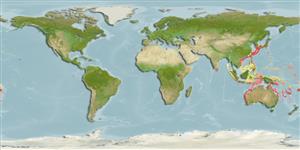Environment: milieu / climate zone / depth range / distribution range
Ecología
marino bentopelágico; rango de profundidad 128 - 200 m (Ref. 58018). Temperate
Western Indian Ocean. Western Pacific: recently recorded Japan and New Caledonia.
Tamaño / Peso / Age
Maturity: Lm ? range ? - ? cm
Max length : 23.0 cm TL macho / no sexado; (Ref. 9833)
Espinas dorsales (total): 5 - 7; Radios blandos dorsales (total): 12-15; Espinas anales 4; Radios blandos anales: 15 - 17. First infraorbital without spine on anterior end. Lateral line ends in caudal fin base. No fleshy disk on inner face of exposed area of scale. Anterior and posterior nostrils close together, their distance apart shorter than diameter of anterior nostril. Specimens from the Indian Ocean have more gill rakers than specimens from Japan.
A benthic or benthopelagic species trawled in 128-200 m depth.
Life cycle and mating behavior
Madurez | Reproducción | Puesta | Huevos | Fecundidad | Larva
Paxton, J.R., 1999. Berycidae. Alfonsinos. p. 2218-2220. In K.E. Carpenter and V.H. Niem (eds.) FAO species identification guide for fishery purposes. The living marine resources of the WCP. Vol. 4. Bony fishes part 2 (Mugilidae to Carangidae). FAO, Rome. (Ref. 9833)
IUCN Red List Status (Ref. 130435)
Threat to humans
Harmless
Human uses
Pesquerías: sin interés
Más información
Nombres comunesSinónimosMetabolismoDespredadoresEcotoxicologíaReproducciónMadurezPuestaAgregación para la puestaFecundidadHuevosEgg development
Age/SizeCrecimientoLength-weightLength-lengthLength-frequenciesMorfometríaMorfologíaLarvaDinámica larvariaReclutamientoAbundanciaBRUVS
ReferenciasAcuiculturaPerfil de acuiculturaRazasGenéticaElectrophoresesheritabilidadEnfermedadesProcesamientoNutrientsMass conversion
ColaboradoresImágenesStamps, Coins Misc.SonidosCiguateraVelocidadTipo de nataciónSuperficie branquialOtolitosCerebrosVisión
Herramientas
Special reports
Download XML
Fuentes de Internet
Estimates based on models
Preferred temperature (Ref.
123201): 14.7 - 22, mean 19.2 °C (based on 40 cells).
Phylogenetic diversity index (Ref.
82804): PD
50 = 0.5088 [Uniqueness, from 0.5 = low to 2.0 = high].
Bayesian length-weight: a=0.01259 (0.00571 - 0.02773), b=3.04 (2.85 - 3.23), in cm total length, based on LWR estimates for this (Sub)family-body shape (Ref.
93245).
Nivel trófico (Ref.
69278): 3.8 ±0.6 se; based on size and trophs of closest relatives
Resiliencia (Ref.
120179): Medio, población duplicada en un tiempo mínimo de 1.4-4.4 años (Preliminary K or Fecundity.).
Fishing Vulnerability (Ref.
59153): Low vulnerability (13 of 100).
